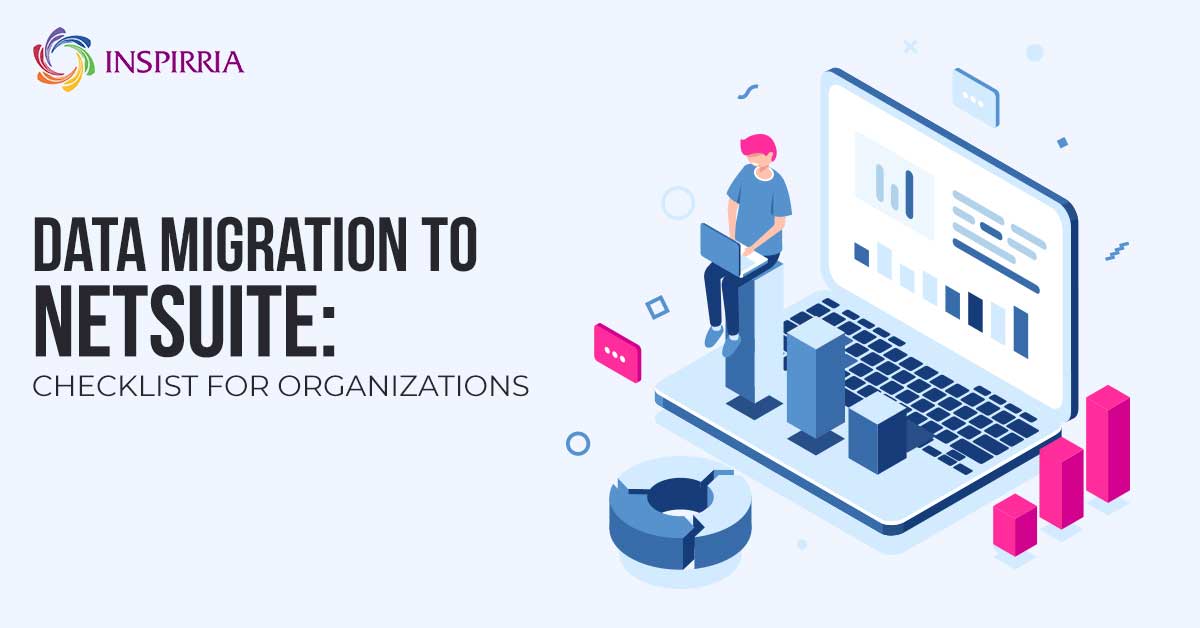Data Migration to NetSuite: Checklist for Organizations

If you are migrating to Oracle NetSuite, then congratulations! You have taken a very wise and informed decision, which will have a long-term positive impact on your organization.
Oracle NetSuite is right now world’s most popular Cloud-based business management suite, and not only it takes care of ERP and CRM, but also helps the management to take decisions, based on hardcore data, and predictions.
Having said that, data migration to Oracle NetSuite is a no doubt chaos, and a complex process.
The entire format of data is redefined, and this means that the Universe is itself transforming, as far as your company’s information architecture is concerned.
Fortunately, we at Inspirria have developed a seamless data migration process, which enables our clients to embrace Oracle NetSuite without encountering any chaos and without disrupting their existing business operations.
Here are the easy 5 steps, which enables smooth data migration to Oracle NetSuite, the Inspirria way:
Step #1: List the Number of Users & Levels of Authority of the Users
The first step in initiating the data migration process into Oracle NetSuite is understanding who will be using the business management suite, and what access do they need. This forms the foundation of the entire migration process, and things simplify henceforth.
Based on the number of users, their access rights, and the rank in the organization, our migration experts will formulate a roadmap for an effective migration strategy.
Step #2: Finalizing the Data Upload Format
Once the users and their access rights have been determined, the next step is finalizing the data upload format for the migration.
The Data Upload Format will be provided by Inspirria Team and the End Users can then be able to prepare the legacy data to be uploaded. The Format for Data uplod is in Excel/CSV
Generally, there are three ways of doing it:
-Select the CSV data format, and use a spreadsheet to export data into NetSuite.
-Manual data upload into NetSuite,
-Third-party tools can also be used to import data from the current system, and upload into
-Oracle NetSuite through Integration, provided we have Open API’s in the Legacy system which can be supported by Oracle Netsuite platform API’s
There are no fixed rules for the same, and depending on the volume of data present, and the existing format of data, our migration experts will determine the data format for upload.
CSV format is the most common, as most of the existing data is in the spreadsheets, and it becomes seamless to use this data format. In some exceptional cases, usage of third-party tools can also be considered, in case the existing data is present in multiple file formats.
Step #3: Preparing For Import
Once the data format for migration has been finalized, we will prepare the system for data import. Now, this is certainly one of the most crucial step, as a single error can play havoc with the entire migration plan, and disrupt the process.
Based on the best practices, Oracle NetSuite has recommended a process for seamless data import, which covers most of the business operations, and creates a solid foundation for error-free data import.
Here are the checking criteria as suggested by NetSuite for initiating data import:
-Classification of data
-Chart of Accounts
-Data related to employees
-Import of Data related with communications and activities
-Import of Data related with relationships/entities
-Finally, import of data related with ERP transaction data
It is suggested by Oracle NetSuite that the import of data based on the selected format should be carried on according to this list, and flow.
Step #4: Creating A Migration Plan
Based on the existing data, and the import flow (as highlighted above), a migration plan needs to be developed for uninterrupted and error-free data migration.
In most of the cases, customers’ data is first imported, followed by contact details and finally automation of marketing. Besides, a field from the customers’ data can be treated as the primary data, which acts as a hinge to validate the rest of the data (Customer number, for example)
Step #5: Executing The Migration Plan
And lastly, the most important part: Executing the migration plan which has been developed for the migration project.
Based on the existing data, and the data format, and the migration plan, our migration experts will execute this last step, and ensure that the legacy data is optimized and re-defined as per the NetSuite requirements.
In case CSV method has been selected, there can be two different paths for executing the Migration Plan:
-Set-up → Import/Export → Import CSV File
-Saved CSV Upload (which can be used for Future Data upload by End Users)
During the execution of the migration plan, it is important to verify and re-verify few vital entities such as fields, forms and records for every row of data.
Besides, our migration experts will make sure that the imported CSV data is aligned with the NetSuite transaction rules, and the imported data fits in with the record types of the new system.
For example, donors, contacts and transactions related data are imported into the supported record types for SCV Import.
Oracle NetSuite has been designed and conceptualized in a manner which makes the entire process of data migration smooth and without any hiccups.
Inspirria, which is a 5-Star Oracle NetSuite partner, has extensive experience and expertise to handle data migration of any magnitude and any depth.
Our Migration Experts can quickly understand your specific business needs for Oracle NetSuite Support, and will accordingly customize and mold the data migration process to serve its purpose.
We will design the migration process keeping in mind that there is minimal downtime, and maximum productivity.
With over 10 years of experience, and 700+ installations of Oracle NetSuite across industries such as automobile, textile, technology, healthcare, and more, we will prove to be your perfect migration partner.
For more information, you can contact us right here.


